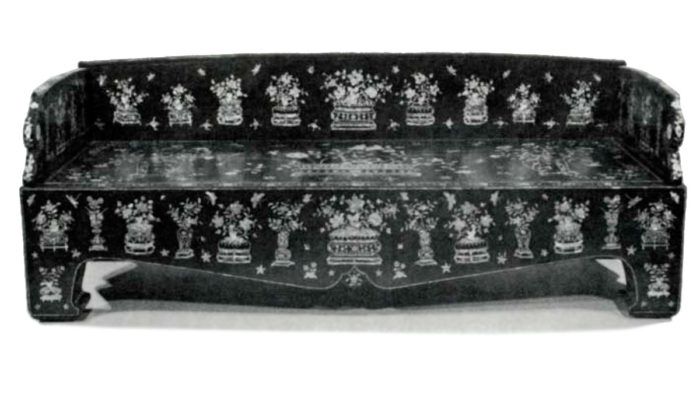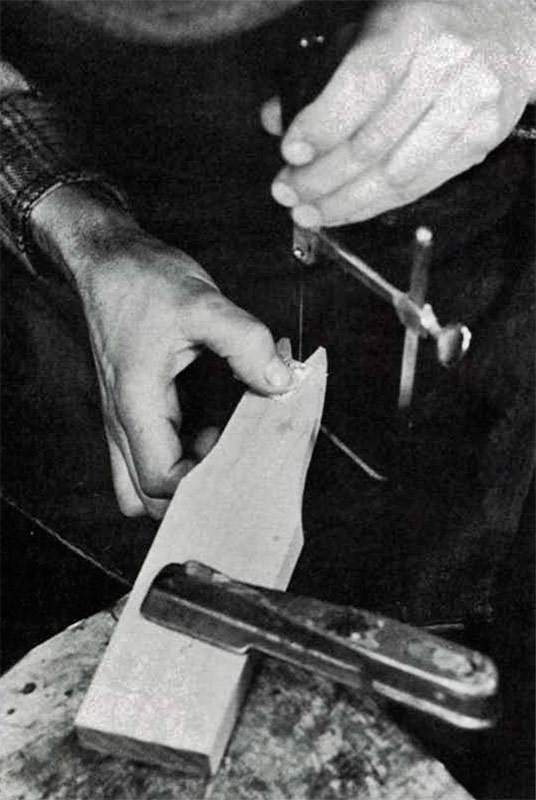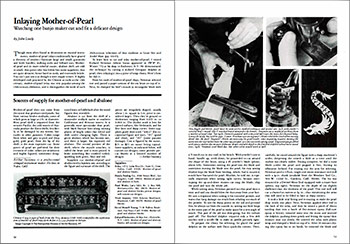Inlaying Mother-of-Pearl
Watching one banjo maker cut and fit a delicate design
Though most often found as decoration on musical instruments, mother-of-pearl inlays traditionally have graced a diversity of articles—furniture large and small , gunstocks, and knife handles, walking sticks and billiard cues. Mother-of-pearl and its more colorful cousin, abalone shell, are sold in small, thin pieces (the box below lists some suppliers), that are quite abrasive, hence hard on tools, and extremely brittle. You can’t just saw it as though it were maple veneer. A highly developed craft practiced by the Chinese as early as the 14th century, mother-of-pearl inlay was very popular among the 18th-century ébénistes, and it distinguishes the work of such 20th-century inheritors of that tradition as Louis Sue and Andre Mare).
 To learn how to cut and inlay mother-of-pearl , I visited Richard Newman (whose banjo appeared in FWW #1, Winter ’75) at his shop in Rochester, N. Y. He demonstrated the technique by cutting a stylized Georgian dolphin in pearl, then inlaying it into a piece of scrap ebony. Here’s how he did it:
To learn how to cut and inlay mother-of-pearl , I visited Richard Newman (whose banjo appeared in FWW #1, Winter ’75) at his shop in Rochester, N. Y. He demonstrated the technique by cutting a stylized Georgian dolphin in pearl, then inlaying it into a piece of scrap ebony. Here’s how he did it:
From his stash of mother-of-pearl chips, Newman selected one and pasted a paper cartoon of the sea beast on top of it. Next, he clamped his bird’s mouth (a rectangular block with a V-notch cut in one end) to his bench. With jeweler’s saw in hand, handle up, teeth down, he proceeded to cut around the shape of the beast, using a #3 jeweler’s blade (see photo). Sometimes moving the pearl into the blade and sometimes moving the blade into the pearl, his easy sawing rhythm kept the blade from binding, which, had it occurred, would have fractured the pearl. Rhythm, he told me, is especially important when sawing tight curves, because interrupting the up-and-down motion can snag the blade, chip the pearl and ruin the whole job.
While sawing away, Newman pointed out that pearl dust is toxic and said you should blow the dust away from your face. He uses a respirator when sawing it for extended periods, and warns that lung damage can result from inhaling too much of the powder. To saw the sharp points on the tail and pectoral fins, he always cut from the outside in, sawing out little loops in the waste part of the pearl to make space for a new angle of attack. This part of the job was slow-going, but the tedium paid off. The finished dolphin required only a few deft touches with a needle file to make its profile precisely right.
 From Fine Woodworking #27
From Fine Woodworking #27
For the full article, download the PDF below:


















Log in or create an account to post a comment.
Sign up Log in